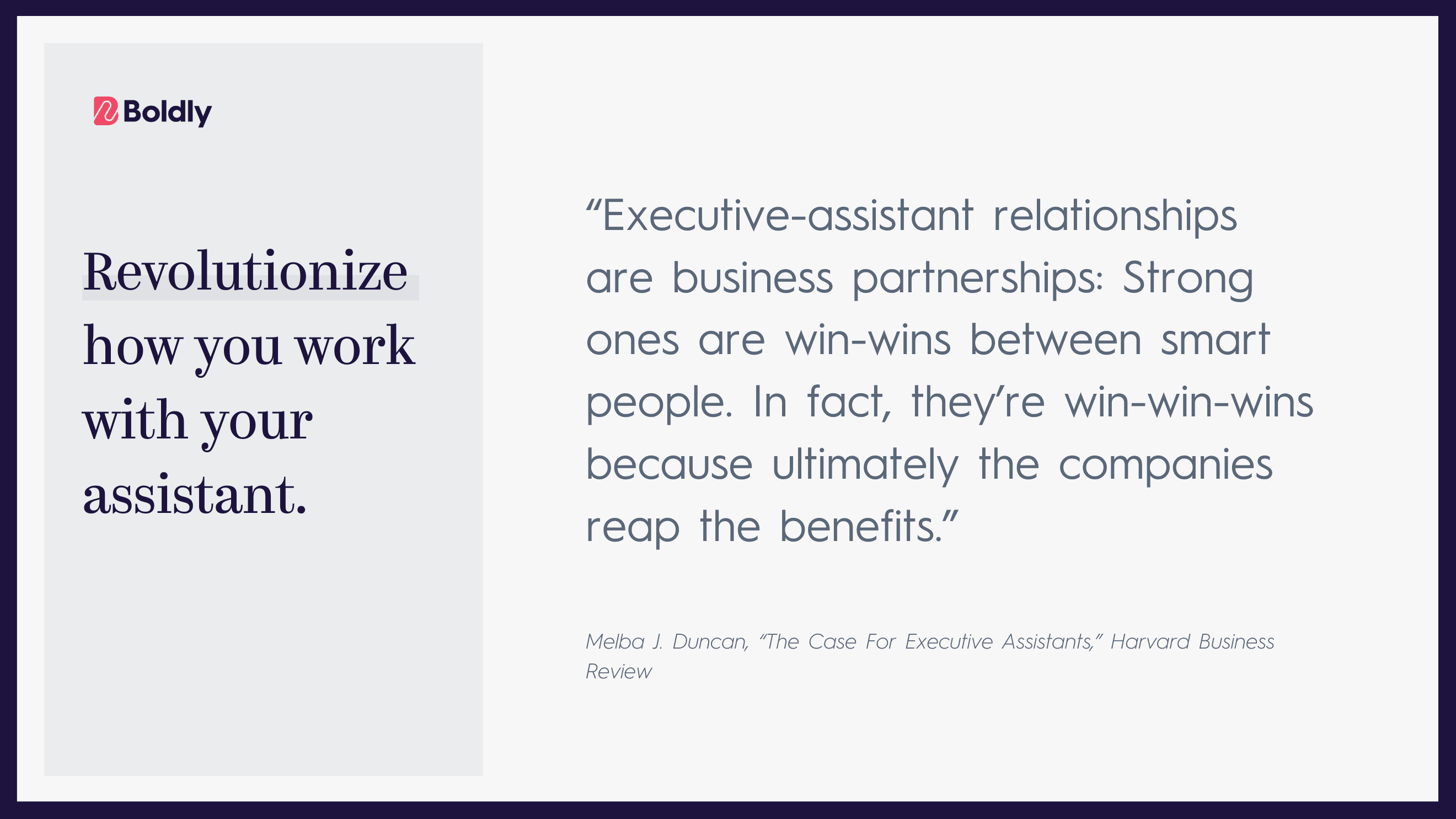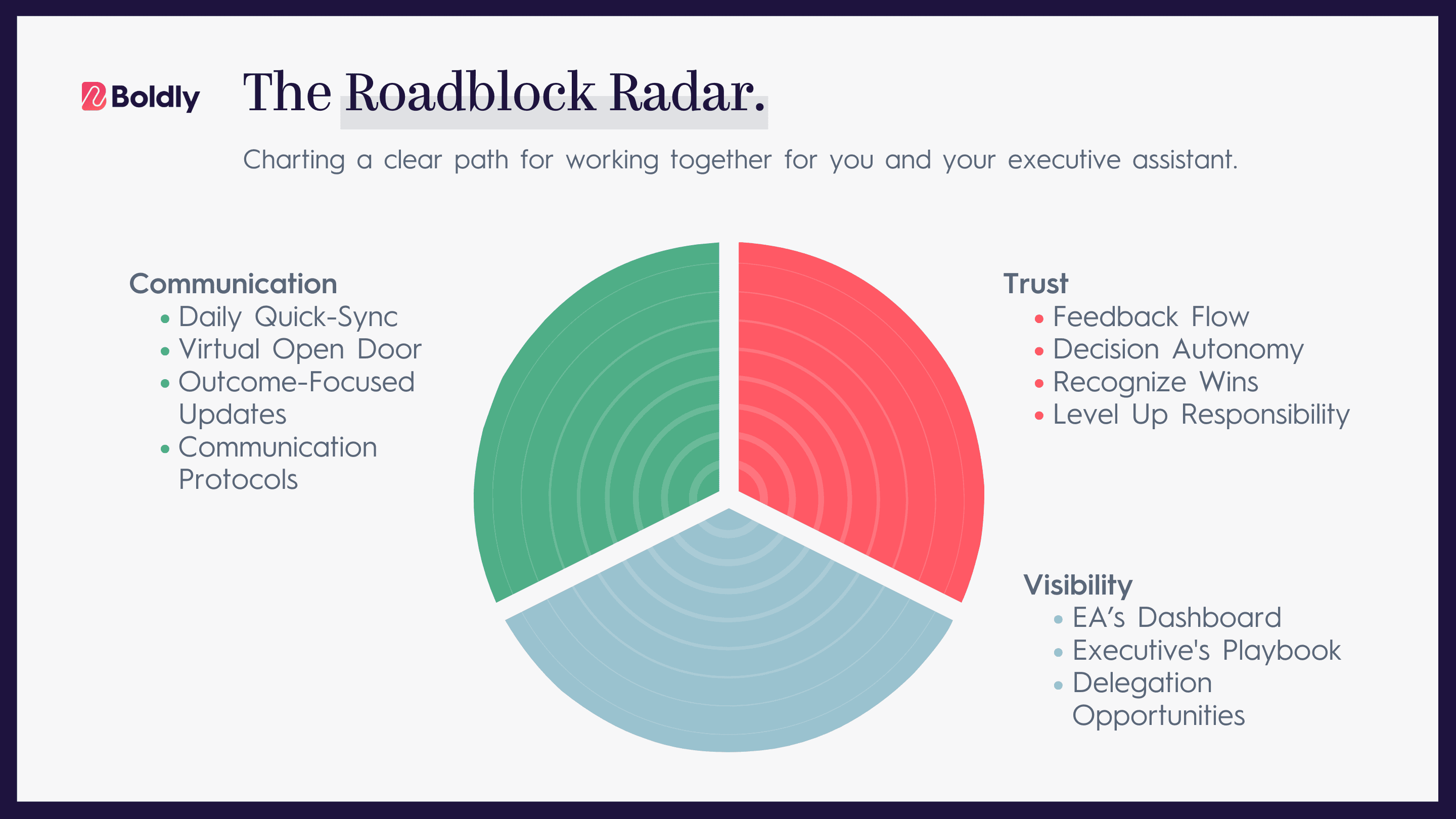Your plate is overflowing, which makes your executive assistant’s to-do list never-ending.
This makes losing sight of the real goals of working together all too easy. It’s like setting off on a journey without knowing the destination.
Senior execs and their EAs need a mutual compass, and that’s where aligned goals come into play. Modern executive assistants excel as both strategists and crucial support.
In this article, we’ll dive into 5 keys to work better with your executive assistant:
- Align Your Goals With Your Executive Assistant’s
- Set Executive Assistant Smart Goals (With 10 Examples)
- Define Meaningful Executive Assistant Goals With 4 Criteria
- Build Your Roadblock Radar With Communication, Visibility, And Trust
- Empower Your EA With The Right Tech For Peak Productivity
When it comes to smart objectives for executive assistants, success hinges on creating a framework that serves both parties. The most effective executive assistant objectives are win-wins, driving both organizational and personal success.
To create a thriving partnership, let’s talk about the power of alignment.
Align Your Goals With Your Executive Assistant’s


“Executive-assistant relationships are business partnerships: Strong ones are win-wins between smart people. In fact, they’re win-win-wins because ultimately the companies reap the benefits,” says author and HBR contributor Melba Duncan.
For you, the “win-win-win” of strategic alignment starts with one of your most important working relationships: you and your executive assistant. When you’re on the same page, success isn’t just a hope—it’s an outcome because it can supercharge your entire company.
It’s not just about getting tasks done, but getting the right tasks done. With every scheduled meeting or sent email, an executive assistant isn’t ticking off tasks. They’re pushing the company forward.
Aligned with a shared vision, these actions don’t just knock out objectives—they drive real growth.
To sum it up, when an executive and their EA work in tandem, it’s not just about collaboration. It’s about crafting a success blueprint where both contribute equally. And that blueprint looks a lot like strategic goals.
Set Executive Assistant Smart Goals (With 10 Examples)
Alignment is about starting with the end in mind. Setting executive assistant goals is about reaching that end with clarity along the way.
You’ve probably heard of SMART goals. Maybe you’ve even set some for yourself. But this goal-setting method will work wonders for you and your executive assistant.
Crafting goals shouldn’t be a murky process. The SMART framework crystallizes it, ensuring each goal isn’t just an aim but a defined path.
So what is a SMART Goal?
- Specific: Narrow it down. What’s the exact aim?
- Measurable: Can you track it? How will you know it’s been achieved?
- Achievable: Set ambitious yet realistic targets.
- Relevant: Does the goal resonate with broader company objectives?
- Time-bound: Deadlines aren’t pressure, they’re direction.
The SMART goal framework transforms vague ideas into precise targets. Creating examples of smart goals for executive assistants helps everyone know what success looks like and track progress. This method will help you establish performance review goals for executive assistants with clarity and purpose.
With the SMART framework in mind, let’s dive into how typical executive assistant tasks can move your company forward. The mission here is contextualizing their work within your company’s, and your own, big-picture objectives.
Here are 10 examples to understand what this might look like.
- Email Management
- Impact: Swift responses don’t just convey efficiency, they build trust.
- SMART Goal: Reduce average email response time for priority communications to under 2 hours during business hours.
- Meeting Scheduling
- Impact: Aligning team members ensures unity and prevents missed opportunities.
- SMART Goal: Ensure that 90% of meetings start on time over the next quarter and agendas are shared 48 hours in advance.
- Travel Arrangements
- Impact: Right location, right time—it can spell the difference between a closed deal and a missed chance.
- SMART Goal: Consolidate travel plans to maximize executive productivity, aiming for a 10% reduction in travel downtime this year.
- Document Management
- Impact: A streamlined document system doesn’t just save time, it mitigates risk.
- SMART Goal: Implement a new document organization system and cut search times by 25% in the next six months.
- Expense Reporting
- Impact: Efficient spending isn’t about cutting costs alone, it’s about smart allocation.
- SMART Goal: Review and categorize monthly expenses, targeting a 5% savings on non-essential spends in the next quarter.
- Regular Communication With Stakeholders
- Impact: Effective stakeholder communication sets the pace for mutual growth.
- SMART Goal: Create a bi-monthly communication plan to keep top 5 stakeholders informed and engaged.
- Project Management & Monitoring
- Impact: Proactive monitoring can pivot a project from potential failure to success.
- SMART Goal: Implement a bi-weekly review system for ongoing projects to ensure they remain on track and within budget.
- Event Organizing
- Impact: Events are brand touchpoints. They leave lasting impressions, for better or worse.
- SMART Goal: Organize two networking events in the upcoming fiscal quarter, aiming for 95% positive feedback from participants.
- Research
- Impact: Accurate, timely research navigates decisions.
- SMART Goal: Initiate a monthly market analysis report to keep the executive team updated on industry shifts and competitors.
- Feedback Gathering
- Impact: Constructive feedback isn’t just data—it’s the roadmap for improvement.
- SMART Goal: Establish a quarterly feedback system for both internal teams and clients, aiming to action at least two significant pieces of feedback each cycle.
Effective goal-setting isn’t about casting a wide net—it’s about precise targeting. Aim right, hit the right target.
Read more: A Guide To Executive Assistant Performance Reviews
Define Meaningful Executive Assistant Goals With 4 Criteria
Next, you will work best with your EA when you go all-in on the relevance component to setting SMART goals.
Try creating some sample goals for an executive assistant to get this right. Remember, the most impactful objectives for executive assistants align with broader organizational goals—so it’s well worth a little more time to ideate and refine them.
Four criteria come into play:
- Transformative Focus: Amid daily tasks, it’s essential to identify what truly impacts the bottom line. Separate the transformative from the routine.
- Complimentary Alignment: The goals of an EA shouldn’t just mirror the executive’s, they should complement and amplify them. Synchronized aims lead to synchronized wins.
- Reasonable Adaptability: A static goal in a dynamic environment can be a misstep. As objectives shift or new information comes to light, the targets should change in tandem. This doesn’t mean allowing the organizational whiplash of constantly moving goalposts. But it does require flexibility rather than rigidity.
- Merge Growth Paths: An EA’s personal growth isn’t separate from the company’s. As they upskill, they uplift the business. Their milestones signify broader organizational strides.
Plus, 68% of employees say they’d stay with their employer “throughout their career” if the employer offered them chances to develop and build new skills.
Read more: Professional Development Opportunities For Your Executive Assistant
To set effective executive assistant goals, each factor should build on the others.
For example, if an EA’s goal is to implement a new project management system, it should:
- Transform workflows (Transformative Focus)
- Support the executive’s efficiency targets (Complementary Alignment)
- Allow for process refinement (Reasonable Adaptability)
- Provide skill-building opportunities (Merge Growth Paths)
Build Your Roadblock Radar With Communication, Visibility, And Trust


Every venture hits roadblocks. It’s not a sign of faulty planning, it’s business reality. Success comes from seeing and sidestepping them.
Here’s where the Roadblock Radar shines: a tool that’s not about predicting the future, but being prepared for it. Let’s unpack its three main gears: communication, visibility, and trust.
Think of your Roadblock Radar as a strategic early warning system. In today’s hybrid work world, it’s more important than ever to keep a clear line of sight between executives and EAs.
Here’s how to make it all work smoothly:
Communication: No Surprises, Just Clarity
- Daily Quick-Sync: A focused 15-minute check-in to align priorities and flag urgent items
- Virtual Open Door: Use tools like Slack for time-sensitive questions that need rapid decisions
- Outcome-Focused Updates: Replace status meetings with shared dashboards and async updates when possible
- Communication Protocols: Establish clear guidelines for urgent vs. non-urgent matters and preferred communication channels for each
Visibility: Show and Tell
- EA’s Dashboard: A tool like Trello can display tasks tackled, in progress, and what’s next. Transparent and current.
- Executive’s Playbook: EAs should know your focal points and potential needs. A brief weekly digest does the trick.
- Delegation Opportunities: Both of you should look for areas where you can delegate faster, better, and more often.
Trust: The Linchpin For High-Performance
- Feedback Flow: Speak up. Whether it’s a pat on the back or a nudge in the right direction, keep it direct and honest.
- Decision Autonomy: Trust EAs with decisions. It’s a time-saver and a trust builder.
- Recognize Wins: Every milestone, irrespective of size, is progress. Acknowledge it. It cements team spirit.
- Level Up Responsibility: As your EA proves reliable in the smaller things, give them increasingly more important work. That could be working with key clients, attending a meeting on your behalf, or even attending to personal tasks.
Think of the Roadblock Radar as your business GPS. It doesn’t predict traffic, but it shows you the jams so you can reroute.
Empower Your EA With The Right AI Tech For Peak Productivity
Today’s EA role is changing quickly, with AI acting as a powerful boost to productivity.
It’s not about replacing human judgment; it’s about enhancing it so your EA can spend more time on high-value, strategic tasks.a
Here are 6 essential tools for the AI-empowered executive assistant to get you started:
- AI-Powered Task Managers: Platforms like Asana and ClickUp are integrating AI to predict task durations, suggest optimal workflows, and identify potential bottlenecks. These insights are meant to strengthen both your team’s approach and execution.
- Communication Platforms: Tools like Slack and Microsoft Teams are now embracing AI to analyze communication patterns, recommending optimal times for meetings or highlighting critical messages that may have been overlooked.
- Smart Calendar Tools: Google Calendar and Calendly now offer AI-powered features that suggest optimal meeting slots based on participant availability and preferences. This ensures that meetings are more productive and less disruptive.
- File Organization Systems: With the integration of AI, systems like Dropbox and Google Drive can now auto-categorize documents, identify duplicates, and even suggest file archiving based on usage patterns, ensuring efficient file management.
- AI-Driven Expense Tracking: Tools like Expensify are leveraging AI to auto-scan receipts, categorize expenses, and predict budgeting trends. This provides EAs with a more accurate and proactive approach to financial management and bookkeeping.
- AI Content Creation: Platforms like ChatGPT streamline content creation, from drafting emails to preparing reports. Tools like this shine when helping EAs produce precise, targeted, and high-quality content quickly.
Best Practices for AI Integration:
- Start with one tool at a time to avoid overwhelming existing workflows
- Focus on automating repetitive tasks first
- Regularly review AI outputs for quality and accuracy
- Invest time in proper tool training and setup
- Keep human oversight for sensitive or complex tasks
Incorporating AI tools boosts your EA’s capabilities, and thus, their productivity. The better the tools get, and the more experienced you and your EA are at using them, the more exponential growth can become. The shift from task-oriented to strategy-driven can become more seamless than ever.
Make sure AI is part of your toolkit.
Teamwork Makes The Dream Work
Success in the executive-EA relationship goes beyond efficiency. It’s about forming a true strategic partnership that drives the whole organization forward.
We’ve covered the essentials—goal alignment, SMART objectives, meaningful criteria, proactive communication, and technology. They’re the building blocks for exceptional outcomes. But there’s one more key ingredient: mutual respect and trust.
Great executive-EA partnerships thrive when:
- Both parties feel safe sharing ideas and concerns
- Professional development is a shared priority
- Wins are celebrated, and challenges are tackled together
- Innovation and process improvements are encouraged
- Boundaries are clear and respected
It’s not just about making work easier. It’s about maximizing one of your most important professional relationships.
By strengthening this partnership, you’re also investing in your organization’s future.
The most effective executives know their EA isn’t just support—they’re a strategic partner in meeting business objectives. By applying these strategies, you’re not just improving a working relationship; you’re unlocking a powerful driver of organizational growth.




